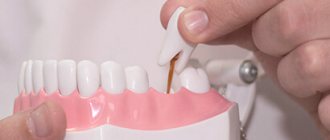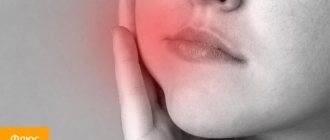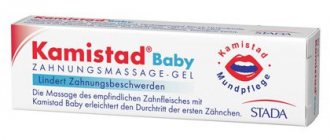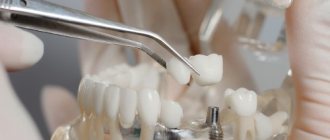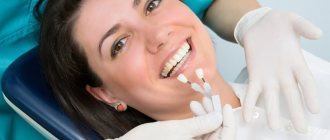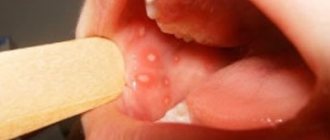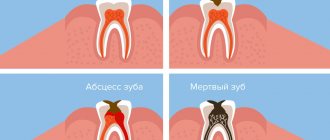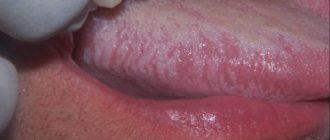The formation of wounds in the oral cavity, or more precisely, on the surface of the palate, can be caused by a number of infectious diseases, and not only. The most common reasons include the development of any infectious diseases, as well as stress, leading to a decrease in the protective functions of the body.
Palpation of inflamed areas of the mucous membrane can be accompanied by acute pain, and the affected areas themselves can complicate the process of chewing and swallowing food, as well as speech function.
Causes of sores in the mouth
The oral mucosa has increased sensitivity to adverse environmental factors. Wounds appear for the following reasons:
- Aphthous stomatitis refers to chronic diseases of the oral cavity. Manifests as ulcers, aphthae on the mucous membrane. With pathology, many ulcerative defects develop on the inner surface of the cheeks, tongue, and palate.
- Herpetic infection affects the skin, membranes, and internal organs. Herpetic stomatitis is manifested by numerous small ulcers, which are located in groups at the bottom of the oral cavity.
- The appearance of wounds on the mucous membranes of the mouth is caused by poor hygiene. Failure to comply with hygiene procedures is more common in children. Babies may suffer from Bernard's afte. They represent ulcerative defects that form on the hard palate from the mechanical impact of foreign objects.
- The wound appears from an accidental bite.
- A hard toothbrush, dentures, dentures, pointed crowns, the habit of biting the lips, and strong blows to the cheeks cause the defect.
- During treatment and dental procedures, the patient may receive minor injuries to the gums, lips, and cheeks from instruments. Dental implantation can also lead to various types of damage to the oral cavity. This is why, among other things, it is so important to trust the installation of implants to qualified specialists.
- The proliferation of fungi on the inner surface of the oral cavity is manifested by ulcers with white cheesy deposits. The first symptoms of candidiasis.
- Lack of vitamins and strong feelings lead to a decrease in local immunity and the appearance of pathological lesions in the mouth.
- Necrotizing periadenitis is manifested by compactions in the submucosal layer, which over time degenerates into painful ulcers. Healing of defects takes a long time.
Why do wounds appear on the roof of the mouth?
Among the variety of causes that provoke the occurrence of wounds (ulcers) on the roof of the mouth, special attention should be paid to factors that can be divided into three categories.
Oral diseases
These common oral diseases include:
- Gingivostomatitis of necrotic type. The development of this disease is facilitated by oral injuries, weakened immunity, hypothermia, lack of vitamins, and the presence of allergic stomatitis. The gums, tonsils, palate, cheeks and tongue are affected. With this disease, the wounds may have a yellow or greenish coating, which causes an unpleasant odor from the oral cavity. Shallow wounds have uneven outlines. Very often, with this disease, the appearance of wounds is accompanied by minor bleeding. The treatment process must necessarily take place in a hospital setting and with the help of drug therapy.
- Herpetiform stomatitis. This disease is characterized by the appearance of sores very similar to herpes sores. In this case, damage to the palate and tongue occurs. The course of the disease usually takes no more than a few days. However, if the wounds do not heal on their own within seven days, you should definitely contact a specialist.
- Necrotizing periadenitis. The initial stage of this disease is characterized by the appearance of small compactions, which after some time become wounds (ulcers). The localization of the disease covers the lips, palate, cheeks and tongue. This causes difficulty while eating and talking.
- Recurrent stomatitis. The localization of wounds and ulcers in this disease covers the palate, the area around the lips, cheeks, and also the tongue. The disease is characterized by the presence of pain when eating, as well as a feeling of discomfort in the mouth. Treatment of this type of stomatitis must begin immediately when the first nonspecific symptoms appear.
- Oral tuberculosis. The course of this disease is characterized by the formation of ulcers (wounds) affecting the entire oral cavity, including the cheeks and surface of the tongue. There is no pain during the formation of such ulcers, but over time the ulcer can grow. During this type of tuberculosis, the wounds are not deep, but have a loose structure. Often the formation of wounds, as with necrotizing gingivostomatitis, is accompanied by bleeding. The wounds have uneven outlines. Treatment of this disease should take place exclusively in a hospital setting and under the close supervision of medical personnel.
How and what to treat wounds on the oral mucosa
Defects in the mucous membrane are manifested by typical symptoms: pain that intensifies during eating, unpleasant odor, metallic taste. Pathology disrupts the normal rhythm of human life. He gets tired quickly and cannot eat due to severe pain.
Cheap antiseptics (iodine, brilliant green, peroxide), which are available in every home, will help remove unpleasant symptoms.
Gargling with hydrogen peroxide treats symptoms of acute tonsillitis. An antiseptic disinfects the oral wound from microorganisms that cause disease. The instructions for the drug indicate only external use. Representatives of traditional medicine advise diluting the medicine with water to avoid unpleasant consequences. Hydrogen peroxide is diluted: take 1 tsp per 120-150 ml of water. antiseptic. The solution should be warm to reduce irritation of the mucous membrane.
Before using the medicine, you should consult a medical specialist. Thus, specialists from the Ibn Sina dental clinic https://stomatologis.ru/ will help identify the true cause of the disease and determine the tactics for treating a wound in the mouth. Hydrogen peroxide is effective if the ulcers have a traumatic, bacterial etiology.
The medicine will not cope with fungi.
The medication can be used 4-5 times a day for 7-14 days. It's important not to overdo it. Incorrect dilution and frequent rinsing can lead to chemical burns of the mucous membrane. Following medical recommendations will help you avoid this pathological condition.
Methods for treating mouth wounds
Before starting treatment for wounds in the mucosa, you should understand the causes of the condition. If ulcerative defects are caused by another disease, it is necessary to fight the underlying pathology to reduce the size of the ulcers.
Wounds that appear from mechanical irritation with a brush or teeth are treated with antiseptic agents. They reduce the risk of bacterial flora attaching.
Therapy for the pathological condition is supplemented by diet, prescription of B vitamins, prevention of exacerbation of chronic pathologies, and elimination of stressful situations.
A patient with recurrent ulcers in the oral mucosa in the absence of treatment effect must undergo a set of tests to exclude a systemic disease of viral etiology (HIV, hepatitis).
Medication
- Chlorhexidine is an antiseptic solution that helps quickly treat wound defects in the mouth. The drug has antimicrobial and disinfectant abilities. Allergic reactions to the composition of the drug are rare. It is suitable for children. Wounds treated with Chlorhexidine can heal in 5-7 days. Rinsing should be done 3-4 times a day.
- Xikain gel has three main effects: reduces pain, destroys pathogenic flora, and relieves inflammation. The medicine is not used in children.
- Asept is a popular spray based on Lidocaine. The drug simultaneously anesthetizes and disinfects the inflammatory focus. The spray is used 2-3 times a day.
- Stomatidin destroys pathogenic microorganisms and disinfects the oral mucosa. The drug is widely used to combat the symptoms of stomatitis. It has a healing effect if you simply bite your lip.
Folk
- Representatives of traditional medicine recommend treating a wound in the mouth after a bite with decoctions of oak bark, chamomile, and calendula. They can be mixed or cooked separately. Take 1 tablespoon of the plant per glass of boiling water. The oral cavity should be rinsed with warm infusion 3-4 times a day.
- Furacilin, soda, and salt will help get rid of the problem. To prepare the solution you will need 5 tablets of the drug, 1 tsp of kitchen ingredients. The listed components of the solution are mixed in a glass of water. You will need 4-5 rinses per day to achieve rapid healing of ulcerative defects.
- A recipe with propolis helps with painful scratches. Take 1 teaspoon of alcohol solution per glass of water and rinse. Propolis relieves discomfort and promotes rapid healing. The soreness goes away within a week.
- Rinses with carrot, horseradish, and cabbage juice are used against stomatitis.
- Kombucha treats wounds in the mouth that form after injuries to the mucous membrane. Improvement occurs after the first rinse.
How to treat wounds on the palate at home?
The most important thing to correctly determine the method of how to cure ulcers on the roof of your mouth is to determine the cause of this pathology. Only after identifying the root causes can you choose the most appropriate treatment. There are two types of treatment for this disease: medication and folk medicine. Let's look at each of them in more detail.
Drug treatment
It should be noted here: the prescription of medications to eliminate ulcers in the oral cavity should be carried out exclusively by a dentist.
Since only a professional doctor is able to determine the exact etiology of the disease and, based on this, prescribe the necessary medications.
We propose to briefly familiarize yourself with some drugs and means that can eliminate both the disease itself and its consequences.
- Antibiotics. Most often, this class of medications is prescribed when the disease is severe. The duration of treatment and the type of such medications are selected strictly individually.
- Two percent gel Xikain. Reduces painful manifestations and successfully fights pathogenic and inflammatory microbes, which helps wounds and ulcers heal in the shortest possible time. The use of Xikain gel is strictly contraindicated for children under six years of age. The reason for this is the presence of components harmful to the child’s body in this medication.
- Medicinal ointments. A very well proven remedy is Benzocaine ointment. Having an anti-inflammatory effect, this ointment can quickly eliminate inflammation in the mouth. This product contains analgesic components, so it is recommended to use it in the presence of pronounced pain.
- Benzocaine can cause an allergic reaction, so it is not recommended for children to treat ulcers. For them, you can use, for example, an ointment like Kamistad.
- Analgesic injections. The only really significant advantage of this type of drugs over others is the speed of action on the affected areas of the oral cavity, which makes it possible to urgently eliminate pain syndromes, especially with open ulcers, when the pain is felt most acutely. However, injections are completely ineffective in eliminating the causes that provoked the appearance of wounds inside the oral cavity.
Traditional methods
There has long been a great variety of folk methods for treating inflammatory processes in the oral cavity. Very often, such remedies are very, very effective and help make the healing process much shorter and more effective.
Let's look at a few examples of such effective remedies from the collection of folk wisdom.
- Rinsing the mouth with a salt-soda solution. It couldn’t be easier to prepare: one teaspoon of soda and salt are dissolved in two hundred grams of cold boiled water. Rinsing is done three times a day.
- Rinsing the mouth with a solution of pharmacy calendula tincture (two teaspoons per two hundred milliliters of warm boiled water). Rinse twice during the day.
- Gruel of finely grated potatoes. Applying such lotions very effectively relieves inflammation and accelerates the recovery and healing processes.
- Rinse your mouth 3-4 times during the day with freshly squeezed carrot juice, slightly diluted with boiled water.
- A very effective way to eliminate wounds on the palate and other parts of the mouth is to lubricate the affected surfaces with natural honey. This procedure will especially appeal to young children.
- Another very effective folk recipe for treating wounds on the roof of the mouth is the following remedy: mix one hundred grams of warm (preferably homemade) milk, one teaspoon of natural honey and one chicken egg yolk. Wipe the affected areas of the mouth with the resulting mixture three or four times a day. This is done using sterile gauze or a bandage wrapped around a finger and soaked in the above mixture. The course of such procedures should be carried out for at least three days.
Review of effective ointments
- Bonafton is used in patients with herpetic lesions of the skin and mucous membranes. The drug has a negative effect on the herpes simplex virus. Suppresses the growth and reproduction of pathogenic microorganisms. The ointment is applied three to four times a day for 2 weeks.
- Solcoseryl is a medicine that is intended to improve metabolism and accelerate regenerative processes. The drug is prescribed for the treatment of inflammation of the cornea and blood vessels of the lower extremities. It fights the manifestations of stomatitis and gingivitis. The drug should be applied to the inflammation site 2 times a day. A positive effect is achieved 2-5 days after the start of treatment.
- Pimafucin has an antifungal effect. The active components of the cream suppress the vital processes of the microorganism. Pimafucin is intended for external use.
- Metrogyl Denta is an ointment for the treatment of wounds in the mouth. Consists of metronidazole and chlorhexidine. The products have disinfectant and antimicrobial properties. The gel is applied 2 times a day for 2-3 weeks.
Features of getting rid of a purulent wound
A purulent wound in the mouth occurs as a result of the active activity of microbes. The condition is accompanied by severe pain and an unpleasant odor. Doctors recommend treating defects in the mucous membrane with antiseptic rinsing solutions and antibacterial ointments. It is contraindicated to pierce or squeeze out the pathological focus on your own to release the purulent contents.
Metrogyl Denta and Cholisal are used for treatment. Rotocan, Chlorhexidine, Givalex are suitable antiseptics. The products are used in dentistry to treat problems of the oral mucosa.
If the pathological process is accompanied by a prolonged increase in temperature, the appearance of pus in the wound, the question of systemic administration of antibacterial agents is raised. They suppress the growth and reproduction of pathogenic microflora in the mouth, promoting a speedy recovery. The selection of effective antimicrobial therapy is carried out by a family doctor or therapist.
Traumatic factors
These include:
- Eating rough (scratching) foods - nuts, crackers, dried fish, etc. Such foods can lead to damage to the mucous membranes and epithelium, which, in turn, can cause wounds to appear.
- Thermal and chemical burns - too hot drinks and food, careless handling of various types of acids. The adult population is most susceptible to this factor.
- Rough or improper oral hygiene. The mucous membranes of the child’s oral cavity are most susceptible to this type of damage.
- Incorrectly installed braces, crowns or dentures.
- Teeth brushing performed inappropriately.
- Microcracks in soft tissues that occur after bites.
- Improperly performed oral sanitation.
The causes of ulcers (wounds) can be the use of medications or food products containing various acids and alkalis. It is the latter that can cause painful irritation both in adults and, for example, in infants.
The possibility of such irritation should be taken into account when choosing a particular medical product, food product or hygiene product intended for oral care (various rinses, toothpastes and powders, etc.).
Rules for processing and treatment in children
Ulcerative defects on the mucous membrane in children appear when personal hygiene rules are not followed. Children can injure the inner surface of the oral cavity with foreign objects. Before starting treatment, it is better to consult a pediatrician. Pharmaceutical drugs, when used incorrectly, cause allergic reactions in children's bodies. You can treat a wound in the mouth using special ointments, gels, and powders.
Children are prescribed Solcoseryl, Chlorophyllipt, Stopangin, Furacilin.
At home, you can use an infusion of calendula or chamomile to wash ulcers.
Pain syndrome in children older than six months is relieved with Ibuprofen and Paracetamol.
When treating the oral mucosa, you must adhere to the following rules:
- You cannot independently increase children’s doses of medications or the frequency of administration.
- If the child does not know how to rinse his mouth, then it is necessary to lubricate the wounds with antiseptics. Do not allow your baby to swallow the medicinal solution.
- If allergic rashes appear, stop treatment and consult a doctor.
- When treating a wound, it is necessary to follow the rules of using aseptic techniques. Before treatment, wash your hands and lubricate the inflammatory areas with a clean cotton swab with the applied medication.
